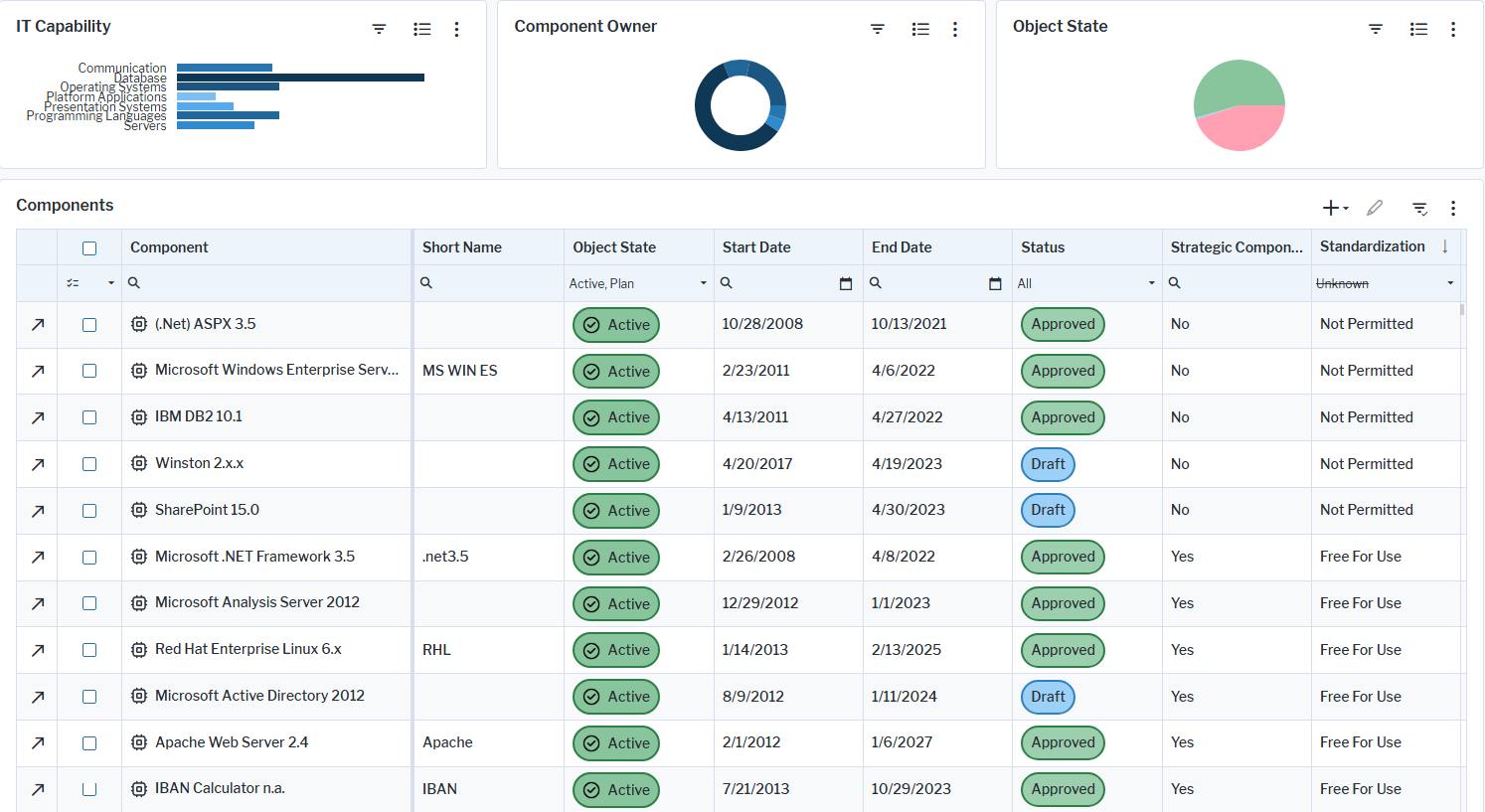What is our technology portfolio?
The business question What is our technology portfolio? offers a comprehensive analysis of the components in your IT and ensures a single source of truth about your technology portfolio.
Get an overview of the IT capabilities that are supported by the most components, which organizations own the most components, and the object states of the components in the technology portfolio. Review a master list of all components including indicators and the most important information about their relationships to other assets in the IT architecture.
The license package IT Transformation Server - Enterprise is required to work with this business question.
Use the method that is most convenient for you:
- In the left navigation panel, enter What is our technology portfolio? in the Search Navigation field.
- In the left navigation panel, click Home. In the content area, go to the Business Questions page and click the tile for What is our technology portfolio?
- In the left navigation panel, expand the sections Business Questions and Transparency and click What is our technology portfolio?

This business question shows the following information:
- IT Capabilities: The bar chart displays IT capabilities based on the number of supporting components. Point to a bar to display a tooltip with the name of the IT capability and the number of components supporting it. Click IT Capabilities to navigate to a larger view of the chart.
-
Component Owner: The doughnut chart shows organizations on the second level in the organization hierarchy based on the number of components that the organization is responsible for. This includes the components assigned to the subordinate organizations in the hierarchy. To understand how many components are owned by an organization on a subordinate level in the organization hierarchy, click the
 local filter button and specify the organization's name.
local filter button and specify the organization's name. - Object State: The pie chart shows number of components having an Active, Plan, and Retired object state.
- The Components data workbench shows a master list of all components. You can use all features of the data workbench to slice-and-dice your data to do the analyses you are interested in.
If you have the relevant access permissions , you can edit the components in this business question. The Components data workbench shows a master list of all components. Use the features of the data workbench to slice-and-dice your data to focus on data and do the analyses you are interested in. For example, review how many components will reach end-of-life soon and assess the complexity of the technology landscape.
Here's what you can do to change the data in the view according to your needs:
- Click the
 global filter button and specify the filter fields to focus the data on a specific IT capability, component owner organization, and component object state. The global filter will be applied to all business charts and the Components view.
global filter button and specify the filter fields to focus the data on a specific IT capability, component owner organization, and component object state. The global filter will be applied to all business charts and the Components view. - Click the caption Components to drill down to have more space and to focus only on the data workbench.
- Click Structure and add or remove columns to the data table. A tooltip explains the purpose of each attribute, indicator, and role that you can add.
- Set filters for columns by entering filter criteria in the column header. Click Clear in the bottom right corner to remove the filter settings.
- Click Visualize to view the data in a different graphic visualizations. You can save these visualizations to your content repository and used them in other content area pages.
- Click the
 plus sign button to create new components directly in the context of the business question.
plus sign button to create new components directly in the context of the business question. - Edit existing components directly in the data workbench.
- Select a component and click the
 navigate button to open it's content area.
navigate button to open it's content area.
Components must be in the repository and well-documented to have meaningful results for this business question. The following data must be captured for each component to have meaningful results for the business question What is our technology portfolio?.
- End Date attribute: Specify to avoid potential conflicts and risks due to end-of-life technologies.
- Component lifecycle: Specify to understand dependencies between end-of-life technologies.
- Component Owner role: Specify who owns the component and is responsible for managing the functional requirements.
Go to the Data Quality page. The Data Completeness view indicates the data that is recommended for meaningful results to the business question. The Data Completeness view indicates the data that is recommended for meaningful results to the business question. Scroll to the Pending Issues view to resolve the issues and to ensure that the data is complete. Only the first 5000 issues are displayed.
Go to the Data Source page to review the component data that is used to answer the business question. The data source is a list report and cannot be edited.